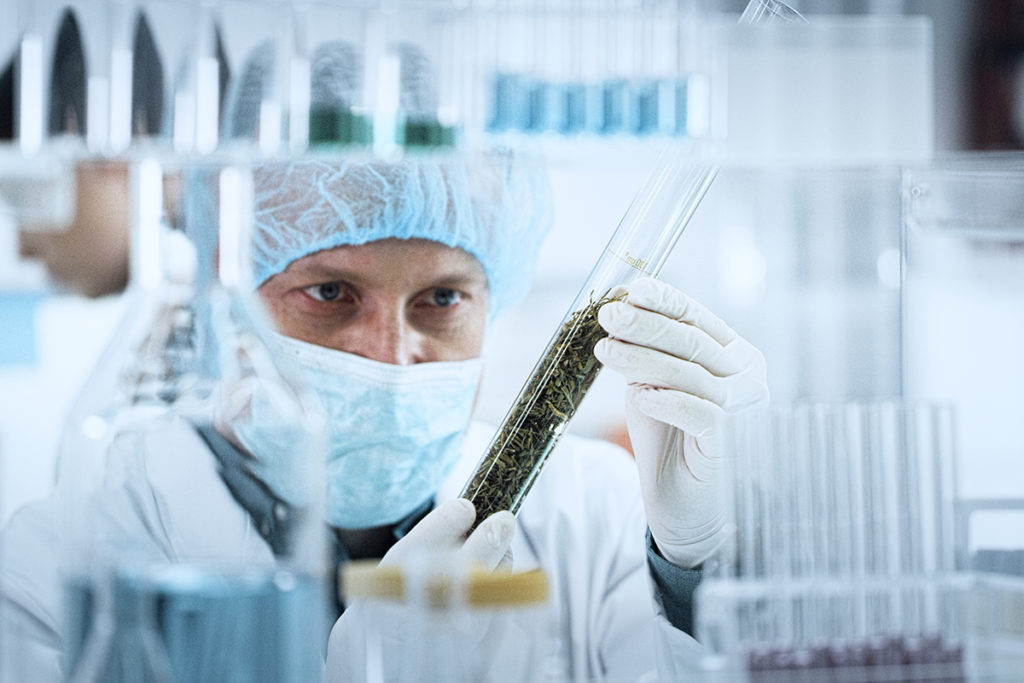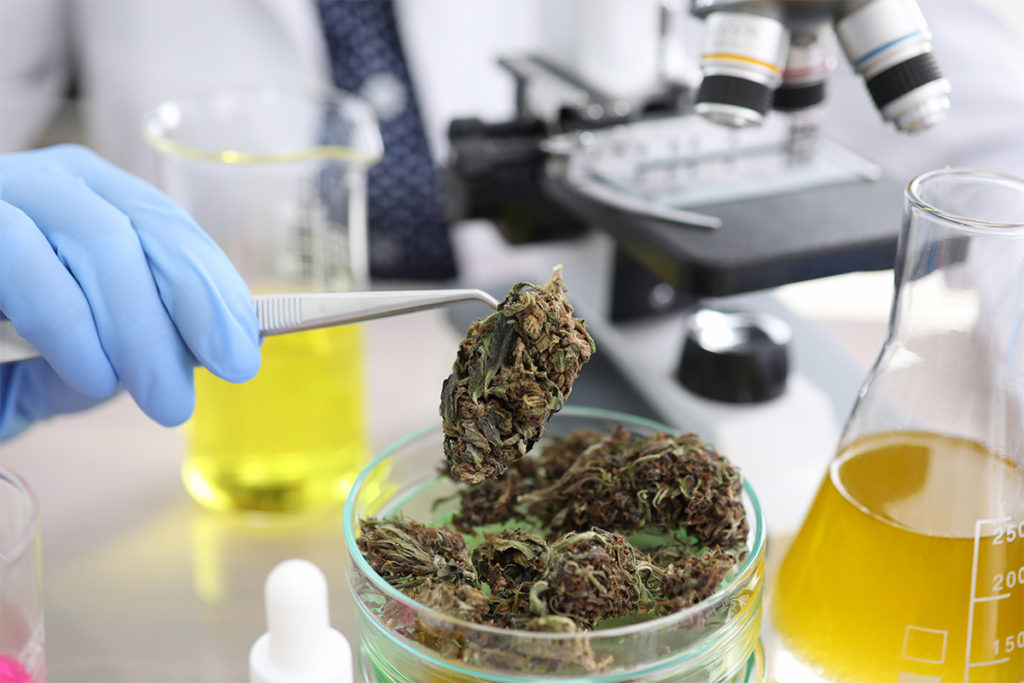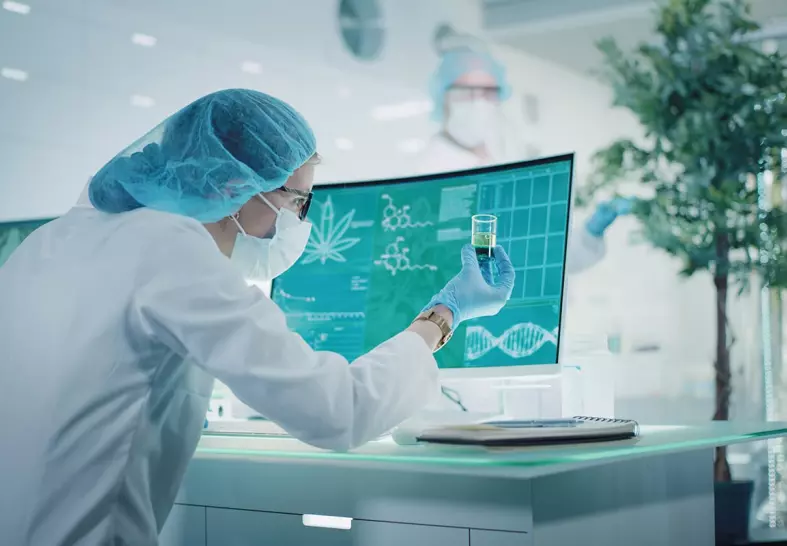
When my roommate’s basement XJ13 lab tested at over 24% THC potency in 2013, High Times’ "Strongest Strain on Earth" was a 27% THC Ghost Train Haze. That XJ packed a decent punch but the results still didn’t sit right with me. For only $50 dollars more an ounce, I could walk down the street and get something way stronger.
If the basement grow was really that close to maxing out THC potency, could the “entourage effect” really be what made good weed feel stronger? What were the results of cannabis potency testing really telling me?
Two years later, on one of my first visits to a recreational store in Seattle, I found a potency label that broke the laws of math and physics: 103.5% Total Cannabinoids. At first I laughed, thinking how many dabs did it take for that stroke of genius?
But I’d soon discover that printing an accurate cannabis potency test would take a lot more than fixing silly mistakes. Sure, deceptive practices were (and still are) widespread, but the industry has also faced some very new and sudden challenges that will take more time to work out, even with utmost integrity.
Let’s take a closer look at the science of marijuana potency testing!
The Science of How to Measure THC Potency
As much as we all got used to ‘judging a bud by its cover’, most of us have also experienced the letdown of a looker that just doesn’t seem to cook right. That’s one thing that made legal weed so exciting: potency proof on every package! For markets that don’t have samples, or smells, or even let you see the product first, mandatory THC potency testing was a real no-brainer.
Unfortunately, in all the haste and hubbub, an elephant in the room went unnoticed: The science behind cannabis potency testing wasn’t ready yet. Although researchers and organizations like High Times had been analyzing THC concentrations for years, standardizing test results across a multi-billion dollar market is much different than carefully processing a small group of samples from time to time.
Creating a system where millions of test results can be compared to one another takes many years of work from experts, professionals, and agencies like the International Organization for Standardization (ISO), which certifies labs all across the world for precision and accuracy. In recent years, plenty of cannabis testing labs have obtained ISO certification, but there’s still no ISO certification for testing cannabis (due to prohibition) so it’s not actually a check on cannabis-specific techniques and methods.
To make matters trickier, there aren’t any botanical products like cannabis that have been tested on such a large scale, so there’s no universal standard operating procedures (SOPs) from which to develop standards for cannabis testing. For more on that, check out this paper in the Medical Cannabis and Cannabinoids journal, which advocates for better standards in cannabis testing because those standards will actually change how the world of science views all medicinal plants and herbs and not just cannabis – and that’s a big deal!
To get an idea of the status quo, let’s explore how that lack of standards translates into what you see on a cannabis potency label.
A Federal Ring Test For Cannabis Potency Testing
As it turns out, the test that read 103% total cannabinoids was actually normal and doesn't necessarily indicate a mistake or foul play at all (assuming it’s a highly potent product, like CBD isolate). That's because, even with everything else in order, quantitative lab tests almost always assume a tolerance for what we’ll call ‘measurement uncertainty’, which is basically how much the results could be off from the actual value.
For example, if the measurement uncertainty for a sample of 100% Pure THC is about 10% and the lab returns a result of 105%, that still falls within the expected measurement uncertainty. For more details on that, check out this article from Botanacor Laboratories about lab testing CBD. Not quite an exact science, is it?
That type of discrepancy poses a big problem for regulators, and it’s one reason the National Institute of Standards and Technology recently sent over 200 cannabis testing laboratories a set of identical samples to analyze (that’s called a ‘ring test’). The study is still underway but one of its participants sent us the preliminary report. Of the 200 or so participating labs, only 20 tested marijuana (not just hemp), and each of those 20 was sent three different samples. You can find the full preliminary report here (look for Table 2 on Page 7), but we've summarized the relevant data in the table below:
THC Potency Chart for NIST Ring Test
| Plant Sample 2 | Plant Sample 3 | Plant Sample 5 | |
| Target Average | 12.7% | 29.2% | 44.2% |
| Consensus Mean | 14.7% | 29.3% | 42.0% |
| Minimum Result | 10.0% | 19.0% | 26.6% |
| Maximum Result | 23.3% | 40.3% | 59.0% |
Basically, the three samples were expected to test at 12.7%, 29.2%, and 44.2% (the target averages) and the average of values from all 20 labs (the consensus mean) comes to within 2% for each sample. The part that’s interesting is how far off the individual results were from one another. For the 12.7% sample, labs sent back results as low as 10.0% and as high as 23.3%. Results for the 29.2% sample came back between 19.0% and 40.3%. Not surprisingly, the 44.2% sample had the widest range of results spanning from 26.6% to 59.0%.

The problem here is that even though measurement uncertainty of pure THC or CBD powder is about 10%, the uncertainty goes way up for botanical products like flowers or buds that don’t have a homogeneous consistency. If we just look at ‘Plant Sample 5’, we are seeing a measurement uncertainty of 73 percent!
So although the averages balance out pretty well, it’s not like producers are printing the average of 20 tests on a potency label – they’re printing the highest one they can afford to find. And that ability to shop around or retest products until they return the highest numbers (aka lab shopping) is a huge problem for small producers trying to compete.
But instead of sending a sample around to a dozen labs to find the right results, producers can usually save money by patronizing the ones that return those higher values – even if it incurs a higher pay-to-play price. It’s easy to say that’s unethical, but the wholesale price of weed is based on THC potency testing and the margins are razor thin as it is. If you were a producer facing acquisition, or a lab trying to retain clients, what would you do?
Since it seems clear that marijuana potency testing needs time to develop better universal standards, let’s talk about what we can do as consumers.
How Are the Results of Marijuana Potency Testing Still Useful?
Maybe mandatory THC potency tests didn’t work out as well as we thought, but that doesn’t make them totally useless. Personally, unless two products are from the same brand and the difference in THC Potency is over 5%, I pay more attention to the presence of CBD, other cannabinoids, and terpenes.
If you want to do your own trialing at home, don’t forget that density matters, too. We can’t accurately compare the strength of two different products by just taking a pinch, we need to weigh out the same amount each time to account for changes in density (but even I don’t do this very often).
For me, being satisfied really starts with knowing what I want and paying attention to what gets the job done. Some strains tend to come out similar every time and others will vary significantly. When I find a great product, I take note of the breeder, the grower, and the ratio of terpenes when possible.
For consumers that still want to dive into the science and progress of cannabis potency testing, one of the best benchmarks for a cannabis testing lab is The Emerald Test. They no longer publish a list of participating labs but you can still check the 2019 participants list or inquire with your local labs. Their latest report has an overview of findings, but keep in mind this data represents the labs trying to prove their accuracy and businesses that engage in deceptive practices aren’t likely to be a part of The Emerald Test. In other words, The Emerald Test shows that doing things well is possible, but even the most ambitious labs aren’t getting it right all the time.
How Can We Fix the Accuracy of Marijuana Potency Testing?
After learning just how hard it can be to do accurate THC potency testing, we’re feeling less confident about comparing the potency labeling on retail cannabis products.
We’ll be watching closely as the National Institute for Standards and Technology (NIST) pushes forward with the CannaQAP project and wouldn’t be surprised if their second round of ring testing shows a huge improvement over the first. Demonstrating a big improvement from a relatively simple effort by regulators could be a real step forward for the cannabis industry. At the same time, the NIST has its crosshairs on the testing of federally legal hemp and bailing out state-legal marijuana isn’t really on their agenda.
As such, it’s probably misguided to assume that improved standardization will somehow fix the myriad issues with marijuana potency testing that have unfolded in many states. Even with federal standards, many state cannabis programs may still lack the means or authority to identify developing problems and take action to rein them in.
Let’s take a closer look at what some of these labs have really been up to when we send them samples for THC and CBD potency testing as well as pesticide, microbial, and heavy metal screening. After all, we’re talking about highly qualified doctors of analytical chemistry and surely they can make the best of a sticky situation, right? …...right?!?
Introducing… The Scientists in Charge of Marijuana Potency Testing
Unfortunately, the scientific method isn’t what fills out paperwork, it’s the scientists and their lab technicians. When it comes to lab testing weed, there’s such a high mountain of evidence, that we’ve made it too easy to capitalize on deceptive practices. We can’t cover all of it, but let’s peek into a few of the biggest headlines.
In 2019, when the California Bureau of Cannabis Control (BCC) showed up at Sequoia Labs, it had been four months since the Sacramento laboratory last failed a marijuana sample for pesticide residues. Upon arriving, BCC agents discovered that Sequoia Labs didn’t actually have a functioning Gas Chromatography Mass Spectrometer (GC-MS) capable of screening for pesticides. Sequoia Labs’ general manager at that time was Steven Dutra, who told Leafly that lab director Dr. Marc Foster’s excuse was, “I just kept thinking I was going to figure it out the next day”.
Figure out what? How to replace or repair the most integral part of a marjuana testing laboratory when it breaks? They passed every sample sent to the lab for four months straight without working instrumentation.
In 2020, Washington State’s Praxxis Laboratories was shut down for falsifying THC potency test results. If it wasn’t for the clever activism of soon-to-be-fired employee Keegan Skeate, Praxxis Laboratories would probably still be editing test results after-the-fact by lowering the recorded sample weight for each test by 20%, thereby increasing the calculated cannabinoid potency by 20%. Praxxis changed the sample weight on 99% of the 1,190 altered results from May and June of 2020.
Regarding the enforcement actions against Praxxis lab, owner Dustin Newman commented, “I find the [Liquor and Cannabis Board] is acting reprehensibly.” I wonder then, what he thought when his first fraudulent laboratory, Testing Technologies, was shut down in 2016?
During a 2016 audit of Testing Technologies, the Washington State Liquor and Cannabis Board (LCB) found a handwritten note addressed to Dr. Newman which read, “Hey Dustin, Can you do me a favor and not post any flower results under 20 percent, oil under 75 percent, and hash under 40 percent. Please hit me up with an e-mail and I will get you another sample for re-test." Subsequent peer-reviewed research into Washington State and Nevada’s THC potency testing has shown that this is exactly what many labs do for their clientele.
So why was the LCB willing to hand over another lab certification to someone like Dustin Newman, especially after people like Dr. Jim McRae spent years analyzing data to prove that a number of other Washington State labs were altering the values of cannabis potency test results and fraudulently passing dirty samples? Consider this: 1,076 out of the 1,190 test results altered by Praxxis in May and June of 2020 were for the same three producers. High Frequency received 57 bogus results, White Star received 285, and Grow Op Farms received a whopping 734 fraudulent test results.
If everybody had the same access to inflated test results it’d be easier to hope that everything balances out in the end. But when certain heavyweight companies get exclusive access to fraudulent testing and state regulatory officials look the other way, isn’t mandatory THC potency testing just paving the way for a market monopolized by corruption?

What Happens When Marijuana Testing Officials Find Dirty Products?
While we could go on and on about suspended licenses, product recalls, third party results, data analysis, and even published research about dishonesty in marijuana potency testing, it’s simply too much to take in at once. Here’s the point:
Marijuana potency testing has been swamped in disorder since the beginning and evidently it’s not getting better fast enough. That’s not to say these examples represent the character of most cannabis testing labs, but once a single lab finds a way to fudge the numbers for cannabis potency testing, it gets harder and harder for other laboratories to stay in business unless they turn to the same questionable practices.
The same goes for pesticide, microbial, and heavy metal screening, which sound good on paper but haven’t done much to mitigate deception and harm in most states where “voluntary recalls” allow retailers to clear out contaminated products before it’s tracked down and taken off the shelves. Want to ensure you avoid Salmonella poisoning from recently recalled products in Arizona? You’ll have to look up the list of affected products and reference it at the store yourself because according to health department public information officer Steve Elliott, the Arizona DHS does not, “have a complete list to provide and knowledge of whether all products have been pulled from shelves yet”.
In other cases, contaminated batches of flower get turned into concentrated products, which can greatly increase the risk of harm for the end user. Although remediation of “dirty” products is a growing business, we have trouble trusting that the concentrated product will be faithfully screened the second time, especially when many states allow for the product to fail over and over until a single test comes back clean, at which point it’s suddenly considered completely safe. When laboratories like Sequoia and OnPoint exist, why bother remediating when a few retests are likely to get your product on the shelves?
It’s worth reiterating that, in many cases (Including with Praxxis and Sequoia), enforcement efforts are triggered by employee whistleblowers and not regular inspections or standard regulatory procedures. But when it seems like government regulators can’t even protect consumers in the rare instance that a producer like Grow Op Farms gets busted for pesticide contamination, well, we’re about ready to give up the fight.
At the end of the day, this type of scandal isn’t news to anyone who’s been involved in cannabis potency testing or pesticide, microbial, and heavy metal screening, so how about some good news? Fortunately, there’s people out there who have spent the last two decades figuring out how to do cannabis testing the right way. Let’s take a closer look at a few of the long-time advocates!
Who Are The Industry Leaders in Safe and Accurate Marijuana Testing?
Even though we’re ready to generally ignore THC test results, we can’t earnestly suggest ignoring what could be a life and death issue when it comes to pesticide, microbial, and heavy metal screening. We need to look for leaders with a reputable track record when it comes to our health. In the first part of this piece, we mentioned the Emerald Test, so let’s take a look at who has been holding it down for us the whole time!
California-based consulting firm The Werc Shop is definitely one of those leaders. What originally started as a handful of cannabis testing labs has evolved into a consulting business that advises other laboratories on how to achieve proficiency in marijuana testing. Other leaders in the space include members of the Association of Commercial Cannabis Laboratories (ACCL) like CW Analytical, which is led by Dr. Robert Martin. One of Dr. Martin’s newest projects is the QualitySafe consumer advocacy group, which he describes as “the first cannabis consumer advocacy association”.
Although both of the above consult with laboratories across the country, it can be hard for consumers outside of California to sift through local providers in search of those connections. One of the ACCL laboratories that may be operating in your home state is Steep Hill Labs, which has been advocating for and educating consumers (and other laboratories) on these issues for nearly a decade. Steep Hill has been very adamant about licensing their brand worldwide without compromising integrity. In many of the markets they serve, Steep Hill Labs still returns consistently lower cannabinoid concentrations than their competitors and that not only makes us feel better about their marijuana potency testing, but it also gives us confidence in their pesticide, heavy metal, and microbial screening.
Marijuana Potency Testing Isn’t Saving You Money
We don’t want to pretend that anyone thought this was going to be perfect, and we definitely think that laboratory testing is an integral part of the cannabis industry. It’s just that what it's supposed to do in most situations is awfully diverged from the reality of its many pitfalls.
So if marijuana potency testing doesn’t do much to protect us or help us budget our legal weed money, then what is it really good for? The real purpose that it’s served has become abundantly clear: in markets where you’re expected to make overpriced purchases without seeing any product, potency testing is the one thing that corporate cannabis vultures want you to see before spending your hard-earned money.
You can bet the farm many of the industry’s biggest players still think we’re all too stoned to know the difference, and for a while, they had us fooled, too. But it’s time to look for more than that THC potency test and start figuring out what really matters. And that might be something unique for each and every one of us, so we certainly aren’t letting a label tell us what to spend our money on!
